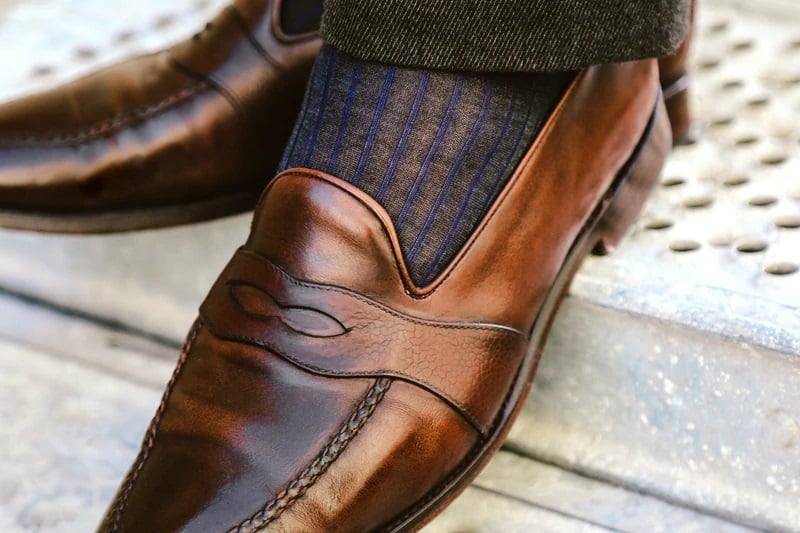Mid-calf socks in Cotton lisle
Mid-calf socks in cotton lisle
The 100% cotton lisle mid-calf socks (short) are a must-have in your wardrobe.
Men's cotton lisle socks are light and thin and can be worn all year round, even in winter (if you're not too scared of the cold!).
Cotton lisle is a high quality Egyptian cotton that allows for sumptuous colours in plain or patterned socks.
Cotton-lisle socks

Where do cotton-lisle socks come from?
Why is it called cotton-lisle, but also Cotton lisle? Contrary to what you might think, Cotton lisle doesn't actually come from Scotland! It takes its name from the nationality of the man who invented the mercerization process, John Mercer, to obtain this clean, shiny cotton yarn, two characteristics unique to cotton-lisle.
How are socks made? Cotton-lisle socks are knitted from a cotton yarn that goes through a very specific transformation process to produce socks of exceptional quality. First of all, after the cotton plants have been harvested, the cotton fibers are twisted together to form a long, compact yarn. Because of the texture of the fibers, the resulting yarn is often unclear, with fibers protruding from the yarn. In this case, the yarn is mercerized, a process that eliminates the protruding cotton fibers and produces a clean, shiny yarn of superior quality. This yarn is then knitted on machines (Italian for our socks!) to produce the famous mid-calf (short) cotton-lisle socks.
Fun fact: The top part of the sock (which runs up the leg) is knitted first, covering the foot like a tube. The machine then stops to reknit the sock, which joins the top and bottom of the sock at the toe. It's this particular technique that enables us to knit socks with no center seam at the toe, ensuring maximum comfort!
Where does the cotton-lisle yarn in our socks come from? Our fil d'Écosse socks are mainly knitted from premium quality yarn from Egypt. Why Egypt? Because it's here that the best cotton is grown, resulting in an exceptionally high quality cotton-lisle yarn, and therefore cotton-lisle mid-calf (short) socks that live up to your expectations!
When and how to wear yarn socks?
Fil d'Écosse socks are thin and light : they can be worn all year round in all types of footwear! If you're sensitive to the cold, we advise you to keep your cotton-lisle socks on in summer, autumn and spring. And in winter, opt for warm, insulating materials such as mid-calf wool or cashmere socks.
Our cotton-lisle yarn socks are ribbed, a detail that adds an extra touch of elegance to your formal outfits and lightly dresses up your casual wear (they can also be worn with sneakers for a chic casual effect!).
We offer several models of Cotton lisle mid-calf socks (short):
- Plain cotton-lisle socks: we offer over thirty plain color variations, from the most classic (black, navy blue, green, gray) to the most extravagant (red, orange, yellow, pink, apple green, etc.).
- Patterned cotton-lisle: vanilla socks (or socks with colored ribs), houndstooth socks or caviar socks, all color combinations are possible thanks to the sumptuous models from Mazarin, Bresciani and Gallo.
N.B.: And if you love cotton-lisle but find that your socks often have holes in them, opt for our super-strong cotton-lisle socks! These socks are the toughest in the world, thanks to a combination of the best natural and synthetic materials (polyamide is what gives them their particular robustness). They're slightly thicker than cotton-lisle, but thin enough to slip into all your shoes.
Caring for your cotton-lisle socks
As cotton-lisle is a particular type of cotton, cotton-lisle socks are fairly easy to care for:
- They can be machine-washed on a conventional setting (e.g. 30° and spin at 1200 rpm);
- To dry, they should ideally be dried flat to retain their shape, but they can also be tumble-dried without any problem (cotton doesn't mind tumble-drying!).

N.B.: the process used to mercerize Scotch yarn makes the yarn more resistant and favors the absorption of dyes. Mercerized socks will keep their color like new even after several washes!
The commitment of (my) red socks made from fil d'Écosse
As you probably know, cotton is a very water-intensive material. And as the majority of our socks are made from cotton-lisle yarn, we are directly concerned by the issues linked to cotton growing and water consumption. That's why we work every day with our suppliers to promote more sustainable crops that respect natural resources.
With this in mind, we have selected our cotton-lisle producer from Egypt. Our geographically short production chain also reflects this commitment to reducing our CO2 emissions as much as possible, by favoring a single Cairo-Milan-Paris axis.
To this same end, we also create innovative ranges based on organic cotton, such as our non-compressing socks in 85% organic cotton, which are softer, more flexible and more environmentally friendly to produce. In fact, all our Italian partner factories are OEKO TEX certified, and the dyes they apply to the yarns are OEKO-TEX Standard 100 Class 1 certified.
 Skip to content
Skip to content

